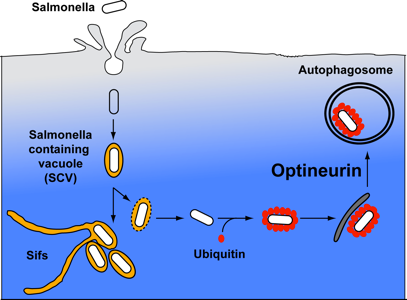New defense mechanism against Salmonella elucidated
26th May 2011
After infection, Salmonella usually accumulates in contained vacuoles inside cells. However, a small percentage of bacteria escape these compartments and start rapidly replicating in the cytosol, a mechanism which is viewed as important for dissemination of the disease to new hosts. This uncontrolled proliferation in the cytosol can be prevented by an evolutionary conserved process called autophagy. Cytosolic Salmonella are recognized, surrounded by a membrane vesicle and marked for degradation via the lysosome.
An international group of scientists around FMLS director Ivan Dikic has now discovered a new molecular link for this recognition of Salmonella by the autophagy membrane. They showed that the protein Optineurin functions as inducible autophagy receptor which is activated by phosphorylation. It binds to ubiquitinylated Salmonella as well as to the autophagosomal membranes, thereby selectively delivering the Salmonella to the autophagy clearance pathway. It is proposed that the phosphorylation of autophagy receptors represents a general mechanism for the regulation of autophagy processes which are operational e.g. in neurodegenerative disease to remove protein aggregates or in cancer development.
Link to full article, to German or English press releas

Scheme of Salmonella infection and clearance via autophagy pathway. The critical intracellular signals are ubiquitin that decorates Salmonella and Optineurin that acts as an autophagy receptor critical for targeting of Salmonella to the degradation in the lysosome.